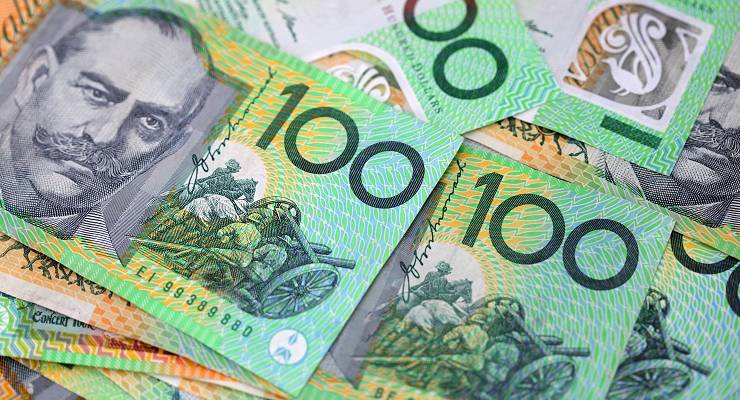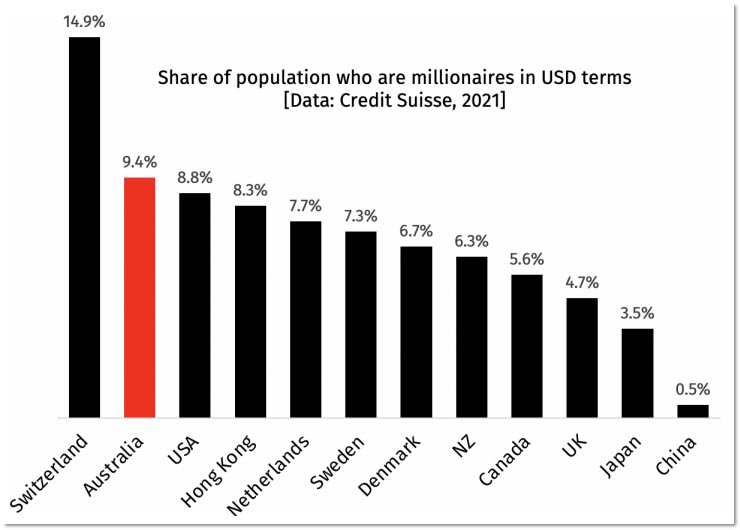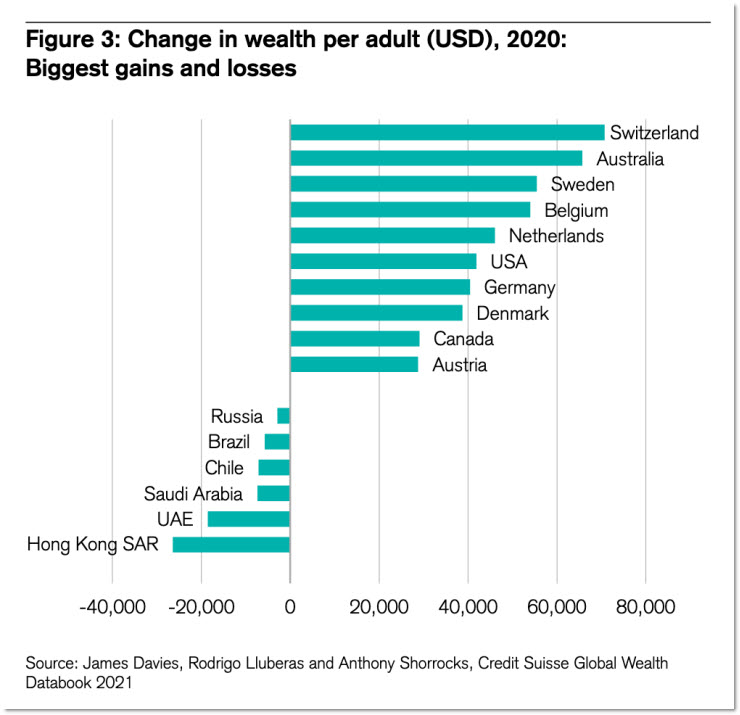
If you’ve got more than a million dollars, here’s the bad news: that’s no longer special. Australia is a nation of millionaires now. Our national wealth is exploding, and the average Aussie household holds $1 million in assets ($1.02 million to be precise), according to the ABS.
Millionaires, millionaires, everywhere you look. We have more millionaires per capita than everywhere except Switzerland. This chart measures wealth in US dollars and tells us that almost one in every 10 Australians has more than US$1 million in assets.

In the pandemic, when it felt like everything was falling apart, wealth got on the elevator and kept going up. As the next graph shows, Australian wealth had a banner year in 2020 because of low spending, low interest rates and a sharemarket that recovered its early losses.

Australian wealth depends on several moving factors. Super is one. As the next chart shows, your super balance depends a lot on your age. The chart also reveals that thinking about “average” wealth can be a bit misleading. If you’re 25 and your wealth is above the Australian average, that’s spectacular. If you’re 55, less so.

Also, in any set of statistics, a big difference between the median and the mean tells you there are huge outliers lurking up one end of the distribution. Such is the situation with super, and indeed with wealth in general. A Credit Suisse report informs us that the bottom 55% of the world’s population owns 1.3% of the wealth, while the top 1.1% of the world’s population owns 45.8% of the wealth.

The difference between rich and poor countries is not that rich countries don’t have people in the bottom section of the distribution. It’s that in rich countries that tends to be temporary, related to being young or major life events. In poor countries people stay in the bottom part of the pyramid their whole life.
The elephant in the room
Of course, no discussion of Australian wealth is complete without talking about house prices — the largest component of household wealth is our homes.
The property market rushed to greater heights in 2020-21, finishing up 13.5%. (Disclaimer: the author recently added to this froth by buying a house. It’s wonderful, I love it, thanks for asking.)
The median house price is up 15.6% to $683,000 and the median unit price is up 6.8% to $569,000 over the past year, according to property data firm CoreLogic.
Rising house prices are not the same as ready cash but they do make us feel richer, and they make us spend more. The Reserve Bank of Australia has found that Australians love to buy nicer cars when their homes appreciate in value. Who wants to put a 2002 Falcon in the driveway of a $1.1 million home? This is somewhat ironic since everyone needs a place to live, so liquidating a house and realising their cash value is quite tricky. Some of us can do it, but not all of us at once!
What happens next?
When you build wealth on a foundation as wobbly as a pandemic, will it last? The authors of Credit Suisse’s wealth report have doubts.
The determinants of wealth levels seem to have become detached from those affecting daily life in a pandemic-stricken economy … Wealth levels have continued to grow as if nothing unusual is happening.
The report authors include ominous warnings: “It appears that either the rules governing wealth evolution have changed in a fundamental way, or else the stage is set for some type of realignment.”
A “realignment”? What shape could that take? The big and obvious risk is that asset prices fall, perhaps driven by rising interest rates. The more expensive it is to borrow money, the less people are willing to pay for a home, for example. The Commonwealth Bank of Australia is forecasting that the RBA will start lifting interest rates as soon as next year. That could put a crunch on house prices.
The main reason to lift interest rates would be rising inflation. We haven’t seen that yet, but it’s worth keeping an eye on warning signs. One such sign is the cost of global shipping. Renting a container to move goods has become extremely expensive as the next graph shows. That will surely flow through to higher prices on imports of goods.

If inflation takes off and interest rates follow suit, the very curious rise in wealth in 2020 could prove an aberration.








Real odd that the targets of stimulus got richer, instead of poorer, despite free money being given to them.
Who’d a thunk it?
Alan Austin writes excellent articles for “Independent Australia”. In recent articles he has shown that the Australian economy is not rebounding as well as many other OECD economies. Also he has argued ( I think) that in the federal government sector our net wealth has declined in recent years because of our growing debt.
Alan Austin says *:
“Through the critical two years, 2009 and 2010, while gross debt deepened by $117 billion, Australia’s net worth declined by $64 billion. So not all of that $117 billion in debt liability was wiped off the nation’s balance sheet. More than half was added to the assets side of the ledger.
Fast forward to today (May 2021): over the last two years, gross debt deepened by $283.1 billion. Over that period, Australia’s net worth collapsed from minus $450.6 billion to minus $746 billion, an overall decline of $295.4 billion. Thus, all the borrowings were wiped off the books. No offsetting assets were added. ”
So may be our total wealth isn’t growing as much as Jason Murphy’s article above suggests?
But of course, by way of the largely untaxed enormous profits from our mining companies which we allow to flow overseas, we are enhancing the wealth of other countries.
It’s not so surprising with Australia’s property obsessions pushing nominal median prices higher (real value probably stagnant) supported by increasing debt for many younger, while our permanent population ages many may have passed or reached peak earnings and wealth?